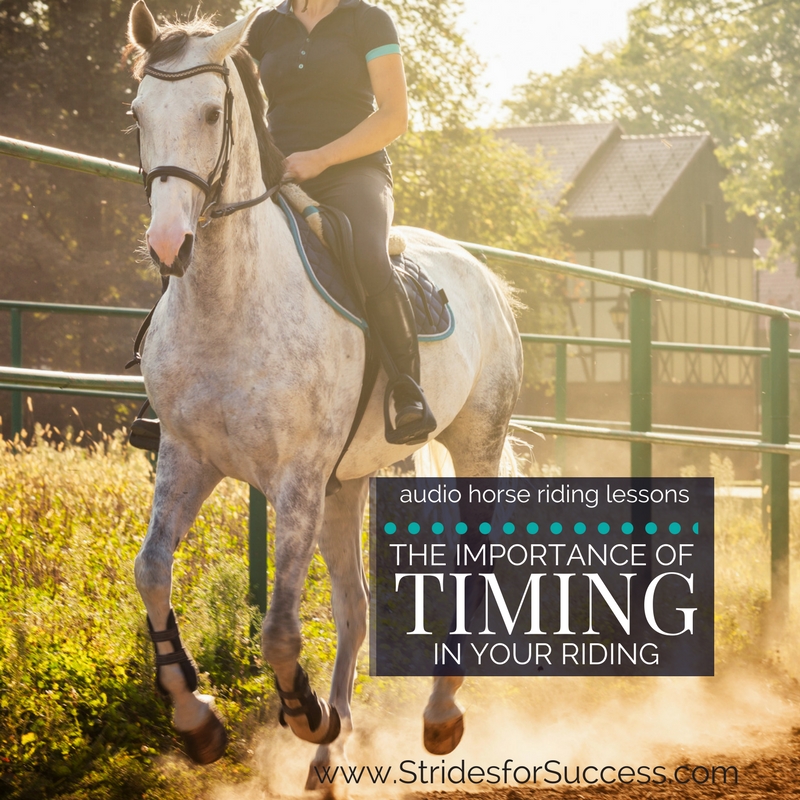
What this episode is all about & how it can help you:-
- Timing – the big picture view
- How to make the best use of your time in each ride
- Using short bursts of time to focus you when you are in the saddle
- Understanding the importance timing when it comes to your aids
Correct timing in your riding is essential to communication, both on the ground and in the saddle, with your horse. In this episode we are going to take a look at timing from the ‘big picture view’ and also the closer, more intricate detail orientated, view.
Timing when Working Towards your Goals
I believe the most realistic and successful way of planning out goals when it comes to horses and riding is working in 90 day (or three month) chunks of time. I think if we look further than that, especially with horses, it can tend to become a little hypothetical.
That being said, it is clearly important to have a realistic picture of what you want things to look like a year from now. Each of your 90 day chunks should be with that ‘year’ goal in mind. Start with the coming 90 days and working backwards from that goal to where you are right now. This is your beginning and the place you will measure your time from.
Timing when Riding Your Horse
Timing is important when you think about the ride itself. From how long you are warming up, to how long you are schooling your horse and then your cool down time.
Rhythm is another way of measuring time and rhythm can be worked on while preparing the horse to be ridden, of course the rhythm while actually riding your horse and also putting the horse away afterwards.
If you plan to have an even, steady rhythm to all the above parts of each individual ride, you will minimise those feelings of being rushed, overwhelmed or frazzled.
Knowing how much time you have before each ride and allocating it out into flexible portions will give you a framework to plug your actual schooling into.
You can also pay attention to the time of day you ride and how that influences both you and your horses way of going. Perhaps there is a time of day when your horse is more responsive or he listens better, more focused and less likely to spook or become distracted. Timing is all about finding what works best for you and your horse.
Timing the Segments of Each Ride
So we have already mentioned allocating time for your warm up, time for the actual schooling, then giving time for the cooling off. However, we can go a little deeper here by focusing on the exercises themselves and what we want to achieve in that ride.
Concerning exercises, many riders are of the opinion that they must simply ride through each exercise a couple of times in order for them to have benefit. I want you to think about if you were to allocate a certain amount of focused time on working through each exercise.
Let’s use the example of 20 minutes for actual schooling work. This 20 minutes of time can be divided up into 6 minutes, 6 minutes and 6 minutes, and I am going to put a minute between the two as well. I realise this is an extreme example, but by giving your horse and yourself a focused 6 minutes and then a minute just to relax and unwind, you will find the quality of the work improves.
This method is proven to work because it stops the exercise from becoming monotonous and never ending. Also, when we give ourselves an end point, it helps us become a lot more focused on what we are doing between now and then.
It helps us assess the quality of the work we are doing. Noticing what you want to work on, and what you want to have made happen when you get to the end point will help you become more consistent and disciplined in the saddle.
Timing of the Aids
Timing can also be used on a very precise split second level in riding with the timing of the aids. Specific aids given at an exact moment in order for your horse to take that direction and make the necessary changes happen regarding his movement.
As riders, it is this type of timing that we look to refine every time we get into the saddle. This is where you should be working every single day. This is what you can focus and concentrate on in those timed schooling sessions. The practiced refinement of the timing of your aids.
This begins when you start working on what is moving when underneath you. Your aim is to feel your way here, not peek over the side!
Knowing what is moving when beneath you, is the foundation for knowing when to apply your aids to get a specific result.
You should ask with your aid at the moment when the horse can respond to your aid. Otherwise your horse may not be physically in a position to respond your aid, resulting in frustrations about a lack of responsiveness.
Start working on developing this skill next time you are in the saddle. Take note of what is moving, when it is moving, how is it moving and where would be the best point for you to act and influence that movement to get the desired result that you are after.
Begin Working on Your Timing Today
It is important to understand the importance of timing when it comes to riding. Taking it from the big picture, 90 day goal view, all the way down to the split second application of your aids in the saddle.
Happy Riding
Lorna
Links mentioned in the episode:-
- FREE Half Halt Training
- https://stridesforsuccess.com/halt/
- Blog Post – How Well Does Your Horse Understand Your Aids
